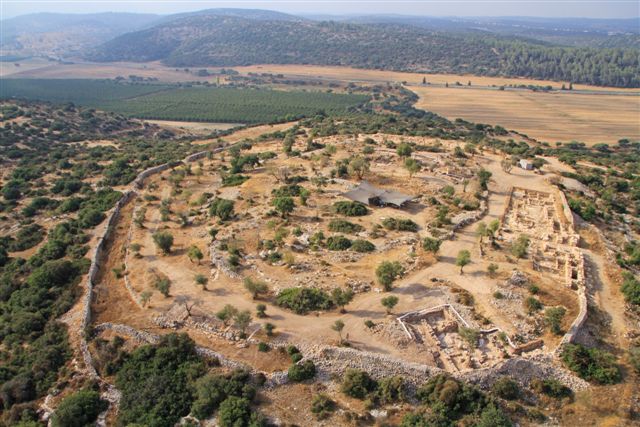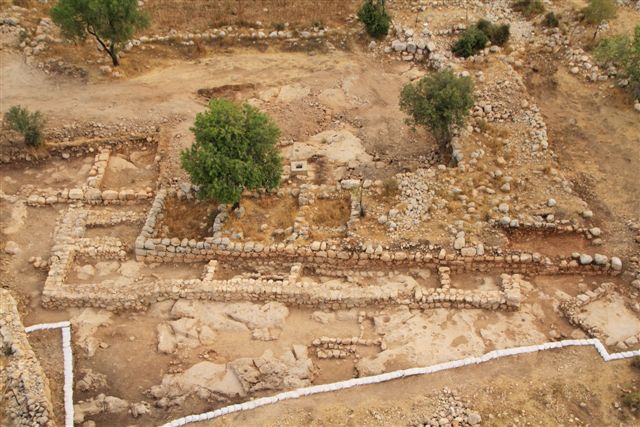 The ruins of a fortified complex at Khirbet Qeiyafa, west of Jerusalem, are the remains of one of King David’s palaces, says Dr. Yossi Garfinkel, archeologist from the Hebrew University of Jerusalem. Working together with Saar Ganor of Israel’s Antiquities Authority, Garfinkel has worked to uncover the site for the past seven years.
The ruins of a fortified complex at Khirbet Qeiyafa, west of Jerusalem, are the remains of one of King David’s palaces, says Dr. Yossi Garfinkel, archeologist from the Hebrew University of Jerusalem. Working together with Saar Ganor of Israel’s Antiquities Authority, Garfinkel has worked to uncover the site for the past seven years.
According to Professor Yossi Garfinkel and Sa’ar Ganor, “Khirbet Qeiyafa is the best example exposed to date of a fortified city from the time of King David.” Maybe the great king ordered citron trees like the ones that flourished in Jerusalem at around the same time to be planted there.
The city was called Shaarayim in Biblical times. Carbon tests date the site at the10th century BCE., when King David ruled over Israel. The absence of pork traces at the site, and objects typically used in Jewish practice discovered there, are clear signs that the inhabitants were Jews.
 Strategically placed for security on a hilltop, the palace would have been one of King David’s administrative and tax collection centers, says Garfinkel. It has an excellent view of the surrounding area, from the Mediterranean Sea at the west, to Jerusalem and the Hebron hills in the east – a perfect location for sending fire signals.
Strategically placed for security on a hilltop, the palace would have been one of King David’s administrative and tax collection centers, says Garfinkel. It has an excellent view of the surrounding area, from the Mediterranean Sea at the west, to Jerusalem and the Hebron hills in the east – a perfect location for sending fire signals.
An enormous pillared room built close to the palace suggests that taxes were stored there.
“It was in this building the kingdom stored taxes it received in the form of agricultural produce collected from the residents of the different villages in the Judean plains,” say the archeologists. “Hundreds of large store jars were found at the site whose handles were stamped with an official seal, as was customary in the Kingdom of Judah for centuries”. Fragments of Egyptian alabaster vessels were found there also.
Workrooms for metal and pottery works were located around the palace’s walls, as can be seen the photo below.
 Garfinkel surmises that King David’s main dwelling was an as-yet-undiscovered palace in or near Jerusalem. The Khirbet Qeiyafa site was most probably where he stopped on his administrative travels.
Garfinkel surmises that King David’s main dwelling was an as-yet-undiscovered palace in or near Jerusalem. The Khirbet Qeiyafa site was most probably where he stopped on his administrative travels.
The archeologists conclude, “Khirbet Qeiyafa was probably destroyed in one of the battles that were fought against the Philistines circa 980 BCE. The palace that is now being revealed and the fortified city that was uncovered in recent years are another tier in understanding the beginning of the Kingdom of Judah”.
More cool archeological discoveries in Israel from Green Prophet:
- The Tooth That Changes Everything
- Ancient Paw Print Found Near Roman Bath In Jerusalem
- 3,500 Year Old Cultic Vessels Found In Tishbi
:: Israel Antiquities Authority
:: Hebrew University of Jerusalem Archeology Department

Yes, thank you.
“Carbon tests date the site at 10 BCE., when King David ruled over Israel.”
Do you mean 10th century BCE?